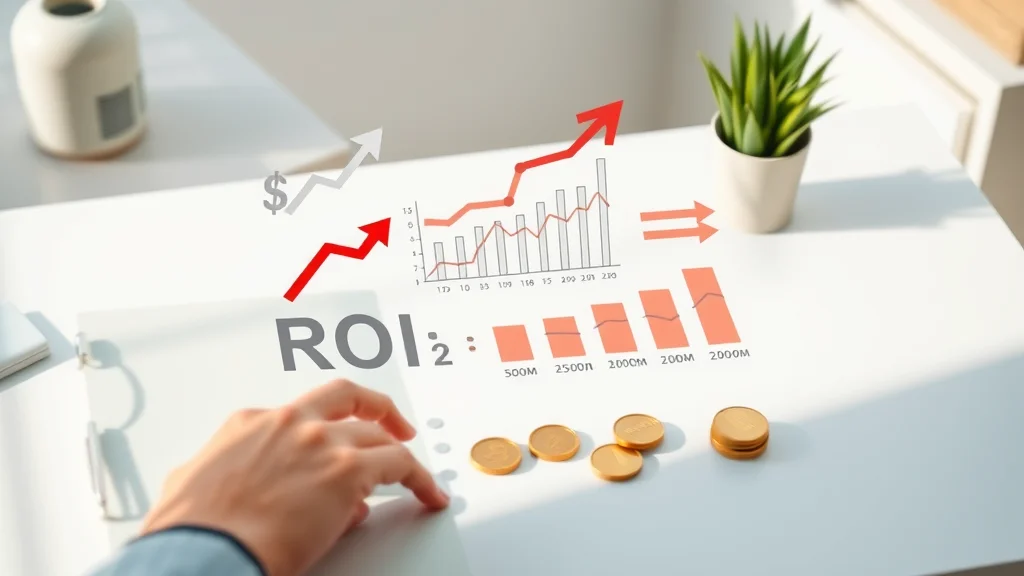Did you know that for every dollar spent on paid advertising, businesses make an average of $2—yet a surprising 38% of ad campaigns underperform simply because ROI isn't measured the right way? If you’re a service-based business searching for actual numbers and actionable guidance, this comprehensive guide delivers surprising data, field-tested insights, and step-by-step strategies to ensure every cent of your digital ad spend drives real results.
Unveiling the ROI of Paid Ads: Insights and Surprising Data
The ROI of paid ads is a pivotal metric for service businesses that invest in marketing campaigns across platforms like Google Ads, social media, and paid search. Recent industry studies reveal that although businesses typically earn $2 for every $1 spent on a digital ad, just under half actually reach this return. Many campaigns falter due to poor tracking of marketing ROI and improper use of ROI calculators. With digital marketing and ad spend taking a larger share of marketing budgets each year, understanding—and maximizing—ROI is no longer optional for growth-oriented businesses.
For service businesses competing in crowded online marketplaces, paid advertising promises an efficient path to scale. However, only those who master the nuances of measuring return on investment can ensure long-term profitability. Whether you run ad campaigns for plumbing, home improvement, consulting, or professional services, leveraging data-driven techniques and tracking every marketing dollar is critical. Next, let's dive into some eye-opening statistics and what you can expect to learn from this guide.
Opening Hook: Startling Statistics on Paid Advertising Effectiveness
“Businesses make an average of $2 for every $1 spent on paid advertising—yet, 38% of campaigns still underperform due to improper ROI measurement.”

What You'll Learn About the ROI of Paid Ads
- Understand the true return on investment (ROI) of paid ads for service businesses
- Learn how to evaluate marketing ROI using actionable data
- Compare different ad campaigns and their real-world outcomes
- Apply proven techniques to improve the ROI of your paid advertising
- Master the use of ROI calculators for precise performance tracking
Defining the ROI of Paid Ads for Service Businesses
Return on investment (ROI) in paid advertising means much more than simple revenue numbers. For service businesses, ROI measures the real financial return of your ad spend against your marketing cost. Unlike retail or direct sales models, the value from a new client or booking often grows over time, making metrics like customer lifetime value and net profit vital for comprehensive ROI calculation. Understanding your actual ROI allows you to optimize digital marketing strategies, reduce wasted ad spend, and increase your marketing ROI across all campaigns.
Many businesses still mistakenly equate marketing success with an increase in clicks or impressions. True ROI, however, factors in the effectiveness of each marketing campaign, conversion rate improvements, landing page quality, and eventual customer acquisition cost. By embracing this holistic approach, service business owners and marketing managers can direct their efforts towards high-performing paid ads and sustained growth, ensuring every ad dollar spent directly contributes to long-term value.
What is Return on Investment (ROI) in Paid Advertising?
In the simplest terms, ROI in paid advertising is the measure of how much profit you generate for each dollar spent on a paid ad. For a service business, ROI isn’t just about the money you get back immediately—it’s also about long-term gains. Suppose your ad spend for a campaign was $1,000 and it brought in $3,000 in net profit. The ROI formula would show a 200% return, making it a high-performing marketing campaign. But there’s more to it than just math: you also need to look at customer lifetime value, how well your landing page converts visitors, and the true costs of digital marketing efforts. This big-picture view separates paid advertising leaders from those who are simply spending without seeing substantial results.

Distinguishing Paid Ad ROI from Other Marketing ROI Metrics
While marketing ROI as a whole evaluates the impact of all marketing activities, paid ad ROI focuses specifically on the results driven by digital ads—across platforms like Google Ads, social media campaigns, and other paid search efforts. Unlike metrics that blend organic reach, content marketing, and email, paid ad ROI isolates the ad spend directly attributed to online ad campaigns and tracks how these investments translate to bookings, calls, or customer inquiries.
- Paid advertising highlights clear attribution paths for each dollar spent on ad-platforms
- Offers granular insight compared to all-encompassing marketing ROI
- Allows for swift adjustments to ad spend and optimization of digital marketing
- Key for monitoring return on investment specific to rapid-response campaigns rather than longer-term branding efforts
How to Calculate the ROI of Paid Ads
Calculating the ROI of paid ads starts with a reliable ROI calculator, but understanding each element is essential for real results. Begin with the basics: subtract your ad spend from the revenue generated by the campaign, then divide by the ad spend. For example, if you netted $4,000 from a marketing campaign that cost $1,500, your ROI is ($4,000-$1,500)/$1,500 = 1.66 or 166%. However, a comprehensive ROI calculation incorporates conversion rate, landing page effectiveness, customer lifetime value, and acquisition cost to reflect real-world marketing ROI.
Using a professional ROI calculator can help you compare multiple campaign types quickly, identify which ad channels drive the best return on investment, and ensure your digital marketing strategies are always data-driven. The further you refine your metrics, the easier it is to benchmark success and identify areas for improvement in ad spend and landing page conversion rates.
Core ROI Calculator Formulas for Paid Ad Campaigns
The foundational formula for calculating marketing ROI in paid advertising is:
- ROI = (Net Profit from Ad Campaign – Ad Spend) / Ad Spend
- Return on Ad Spend (ROAS) = Revenue Generated / Ad Spend
Combining these with tracking tools lets you measure both raw returns and relative efficiency of every dollar spent on ad campaigns. This clear calculation empowers data-driven decisions for any service business intent on sustainable digital marketing.
| Metric | Formula | Example Values | Result |
|---|---|---|---|
| Net Revenue | - | $5,000 | $5,000 |
| Ad Spend | - | $2,000 | $2,000 |
| ROI | (Net Revenue – Ad Spend) / Ad Spend | ($5,000-$2,000)/$2,000 | 1.5 or 150% |
| ROAS | Net Revenue / Ad Spend | $5,000/$2,000 | 2.5 or 250% |
Factoring in Landing Page, Conversion Rate, and Customer Lifetime Value
To sharpen your ROI of paid ads, it's not enough to focus solely on cost and revenue. The traffic you attract with a digital ad is only valuable if your landing page converts visitors into leads or customers at a high conversion rate. Optimizing landing pages—through clear call-to-action buttons, persuasive messaging, and trust signals—can often double your ROI without increasing your ad spend. Additionally, knowing your customer lifetime value (CLV) allows you to justify higher acquisition costs, as long as each new client is likely to provide repeat business or ongoing service revenue.
Many service businesses overlook the synergy between a high-converting landing page and savvy budget allocation. By investing in user experience and tracking real client value over months or years, you transform short-term marketing campaigns into engines of long-term net profit. This comprehensive perspective is what distinguishes high-growth service companies from their competitors.

Tracking Ad Spend and Assessing Return on Ad Spend (ROAS)
A critical measure for every marketing campaign is the return on ad spend (ROAS). While ROI focuses on overall profitability related to marketing costs, ROAS zeroes in on how efficiently your ad spend translates into revenue. Service businesses should monitor ROAS regularly—by campaign, channel, and even customer segment—to pinpoint strengths and weaknesses. Advanced digital marketing tools, such as Google Ads dashboards or third-party ROI calculators, can automate this process and uncover trends, such as which types of campaigns deliver the lowest acquisition cost and highest conversion rate.
Establishing benchmarks for ROAS is essential. For most service businesses, a ROAS of 3:1 (or 300%) is good, but high-performing marketers consistently exceed these levels by focusing on post-click conversion optimization and using real-time analytics to shift ad spend for better marketing ROI results.
The Elements Impacting Marketing ROI in Paid Advertising
Several factors go into shaping the ultimate success of your paid advertising investment. These include how wisely you allocate your ad spend, the relevance and performance of your landing page, the strength of your digital marketing strategy, and especially your focus on conversion rate improvements. Let’s break down these elements to see where service businesses can pull the biggest marketing levers for stronger return on investment.
Optimizing your paid ad campaigns involves strategic planning at every level. Whether you’re targeting new or existing customers, each step—from creative development to marketing efforts assessment—requires monitoring key KPIs using ROI calculators. With a focus on best practices, service businesses can maximize revenue by identifying and doubling down on the tactics that move the needle.
Ad Spend: Allocation and Optimization
The size, timing, and channel of your ad spend are primary drivers of campaign success. Pouring marketing cost into the wrong channels—or spending too little to achieve meaningful reach—can doom campaigns from the start. Savvy marketers use past performance data, audience insights, and competitive benchmarks to reallocate budgets for the greatest impact. Tools like ROI calculators and ad platform analytics make this easier than ever.
The key to maximizing ad spend is consistent tracking. For instance, spending more on paid search might improve bookings for a cleaning business during certain seasons, but shifting more budget to social media in the off-season could boost overall ROI. Always track your ad spend monthly and be prepared to pivot your paid ads strategies based on real-time marketing ROI feedback.
The Role of Landing Pages in Paid Ad ROI
Your landing page acts as the crucial bridge between ad click and conversion. Even the highest-quality paid ad will deliver poor ROI if the landing experience lacks clarity, trust, or relevant information. This means every marketing campaign must include ongoing landing page optimization—testing different layouts, call-to-action placements, and content blocks aimed at boosting conversion rate.
Small improvements can have oversized effects. For example, updating your landing page with a testimonial slider or simplifying the inquiry form may increase conversions by 10–20%, raising the ROI of paid ads significantly without an increase in ad spend. Regularly review analytics and invest in user feedback tools to ensure your landing pages are converting as many visitors as possible from every marketing campaign.

How Digital Marketing Strategies Influence Your Return on Investment
With digital marketing, a thoughtful strategy is essential for stellar ROI. Service businesses that implement targeted ad campaigns—leveraging paid search, social media retargeting, and seasonal Google Ads—see returns that outstrip those using scattershot tactics. Using A/B testing for ad copy and creative, harnessing ROI calculators for immediate feedback, and prioritizing customer lifetime value all work together to fuel better marketing ROI outcomes.
Your marketing strategies should evolve as competition shifts and customer behaviors change. For instance, after COVID-19, many service providers pivoted to online consultations, finding that a well-placed paid ad with a virtual booking option delivered greater returns and higher conversion rates. Continual strategy refinement is non-negotiable for maximizing the return on investment from every digital marketing dollar spent.
The Importance of Conversion Rate Improvements
Conversion rate is the linchpin in the ROI of paid ads equation. By specifically targeting post-click optimizations—such as improving page load speed, using compelling offers, and eliminating friction in booking forms—you can dramatically raise the number of leads or sales per visitor.
“Optimizing for conversion rate rather than just traffic can double your paid ads’ ROI.” – Industry Analyst
This focus helps service businesses gain more from existing ad spend, driving up both net profit and customer lifetime value. Routinely measuring conversion rate, making incremental landing page improvements, and running A/B tests are essential steps in any high-ROI marketing campaign.
Case Studies: Real ROI of Paid Ads in Service Businesses
Real-world examples illustrate that the right adjustments to ad spend, landing page design, and ROI tracking yield dramatic outcomes. In one case, a local HVAC business saw a 2.5x increase in marketing ROI overnight by reallocating ad spend from paid search to social media and updating the landing page with video testimonials. Another, a consulting agency, doubled their net profit in six months by focusing aggressively on their most profitable acquisition sources and upselling existing customers through retargeted paid ads.
Comparative analysis of multiple campaigns provides vital learning: companies that consistently track and optimize their ROI using calculators outperform those relying on instinct. The case studies below demonstrate the growth trajectory for service businesses using a disciplined, data-driven approach to paid advertising.
Comparing Diverse Ad Campaigns: Outcomes in ROI
Looking across several campaigns, we find that businesses using highly targeted paid ads—customized for seasonal offerings or customer segments—often realize better ROI than broad, generic digital marketing strategies. For example, a cleaning business that shifted focus to after-event deep-cleans during local festivals saw ad spend efficiency climb by 40%. In contrast, those with poor ad spend attribution or a lack of landing page testing consistently underperform. Utilizing multiple tracking points and post-click analytics, service businesses can not only compare, but also elevate their ROI benchmarks over time.

Measuring Success Beyond the Initial Conversion — Customer Lifetime Value
For service businesses, the true return on investment of paid ads transcends the first booking. By factoring in customer lifetime value (CLV)—the projected revenue from a client over their relationship with your company—you can confidently invest more in acquisition if you know those customers are likely to provide ongoing revenue. Tools within ROI calculators can estimate CLV, helping service providers assess which channels drive the most valuable clients and inform decisions on re-targeting, loyalty marketing, and upsells.
By benchmarking before-and-after CLV, businesses can track when marketing campaigns are producing short-term wins versus laying the groundwork for lucrative long-term relationships.
| Campaign Element | Initial ROI | After Optimization |
|---|---|---|
| Ad Spend Attribution | 140% | 200% |
| Landing Page Conversion | 7% | 15% |
| Average Customer Lifetime Value | $650 | $1,150 |
| Overall Net Profit | $5,000 | $12,000 |
Common Pitfalls Leading to Low Paid Ad ROI
Even with strong digital marketing strategies, it’s possible to see poor ROI of paid ads by falling into classic mistakes. Many service businesses:
- Fail to use an ROI calculator, missing critical campaign optimizations
- Ignore landing page performance, letting conversion rates stagnate
- Struggle with accurate ad spend attribution, confusing top-performing campaigns with underperforming ones
- Neglect conversion rate optimization, focusing only on traffic increases
- Mistarget digital marketing campaigns, sending ads to irrelevant audiences and existing customers who don’t need immediate service
Regularly reviewing these errors can act as a checklist for campaign audits, helping you spot and resolve the gaps draining your marketing ROI—before they become expensive, systemic problems.

Maximize Your Paid Ads ROI: Proven Marketing Strategies
To ensure your paid ads deliver maximum return on investment, adopt a proactive approach based on data, regular testing, and continuous spending optimization. Service businesses seeing industry-leading ROI are those who:
Retargeting Existing Customers for Higher ROI
Don’t overlook past customers as a prime segment for paid ad retargeting. Data shows that retargeted ads to existing customers have dramatically higher conversion rates and can generate new service bookings at a much lower customer acquisition cost. With tailored messaging and relevant offers, these campaigns often double marketing ROI compared to completely new client outreach.
Add automated retargeting into your digital marketing stack—using Google Ads, Facebook, or email—so your marketing campaigns are always top-of-mind for ready-to-book customers. Consistent communication, even post-purchase, strengthens your brand’s relationship with its most profitable audience.
Balancing Ad Spend Across Channels for Optimal Marketing ROI
Investing all your ad spend in a single channel limits your reach and caps your potential marketing ROI. Top-performing service businesses balance investments in Google Ads, paid search, and boosted social media posts, consistently comparing ROAS and ROI through a robust roi calculator. Adjusting budgets across multiple channels allows you to accelerate spending where you’re seeing the best return and hold back where results lag.
Monthly or even weekly reallocation helps ensure dollars are spent on the highest converting platforms. Consider seasonality, market trends, and campaign-specific performance analytics to inform your decisions and achieve optimal results from every digital marketing effort.

Leveraging A/B Testing to Boost Paid Advertising Performance
A/B testing is a low-risk, high-reward strategy for service businesses to refine every aspect of their marketing campaign—from ad creative to landing page calls-to-action. Simple split-testing can improve results by over 20%, helping you identify exactly what messaging, visuals, and offers resonate with your audience. Use insights from these experiments alongside an ROI calculator to continuously raise your digital marketing ROI with tactical, evidence-driven updates.
“Incremental changes in your landing page can increase your paid advertising ROI by 20% or more.”
- Use ROI Calculator Regularly: Consistent data monitoring means faster adjustment and improved profitability.
- Test Different Ad Formats: Discover which creative, copy, and platform combos perform best for your market.
- Focus on Customer Lifetime Value: Invest more in campaigns that deliver returning and loyal clients, not just one-off sales.
- Monitor/Reallocate Ad Spend Monthly: Respond to analytics and seasonal trends to optimize every dollar spent.
- Prioritize Post-Click Conversion Optimization: Tweak landing pages, forms, and follow-up for higher conversion rates and better marketing ROI.
People Also Ask: ROI of Paid Ads – Key Questions Answered
What is a good ROI for paid advertising?
A good ROI for paid advertising typically falls between 200-300%, though benchmarks can vary. Service businesses sometimes achieve far higher returns by using precise ROI calculators and regularly optimizing their campaigns. What matters most is not the absolute percentage, but the continual improvement and regular tracking of your ROI using professional tools—keeping your marketing efforts aligned with key business goals.
What is the ROI of ads?
The ROI of ads measures the net financial return generated for every dollar spent on ad platforms like Google Ads or Facebook. For service providers, this number is determined by dividing the net profit from marketing campaigns by the total ad spend, adjusting for conversion rate and expected customer lifetime value. The closer you align your measurement to actual long-term business value, the more accurately you can judge the success of any marketing campaign.
How effective are paid ads?
Paid ads are highly effective when implemented as part of a robust digital marketing strategy. The most successful service providers routinely see their paid ad investments drive lasting business growth when they actively monitor marketing ROI, refine their targeting and creative, optimize landing pages, and focus on converting existing and new customer opportunities at every stage of the funnel.
What is the average ROI for Google Ads?
Google Ads campaigns usually deliver ROI in the 200-800% range for well-optimized service businesses. By leveraging advanced ROI calculators, A/B testing, and conversion tracking, many achieve returns well above average, making their advertising investments an engine for repeatable growth. Consistently review your metrics and adapt your digital marketing for the best outcomes.

FAQs: The ROI of Paid Ads for Service Businesses
How do you set realistic ROI goals for a paid ad campaign?
Begin by benchmarking your average return on investment from past campaigns and research industry averages—it’s common to set initial ROI targets at 200%. Adapt these goals as you gain data from each campaign, always using an ROI calculator for accurate performance tracking. Adjust budgets, audiences, and messages as you gain insights to make these goals achievable, not just aspirational.
Can old or existing customers influence your marketing roi?
Absolutely. Existing customers are a goldmine for improving your marketing ROI. These customers are more likely to respond to retargeted paid ads and can deliver a higher customer lifetime value. Focusing some of your digital marketing campaign efforts on re-engaging this group reduces acquisition cost and increases profitability over time.
What's the difference between ROAS and ROI in paid advertising?
ROAS (Return on Ad Spend) measures gross revenue from your ads versus your ad spend, while ROI includes all costs (like creative, staff, and customer support) and subtracts them from net profit. Use both metrics together to understand broad efficiency (ROAS) and true profitability (ROI) of your marketing campaigns.
Should service businesses use a third-party ROI calculator tool?
Yes. Third-party ROI calculators offer more comprehensive and accurate insights than manual tracking. These tools simplify ROI calculation, provide benchmarking, and help manage complex ad spend distributions. They’re vital for service businesses scaling multiple paid ads or marketing channels and wanting to maximize returns.
How often should you assess the ROI of your paid ads?
At least monthly. High-performing organizations track ROI by campaign even weekly, adjusting marketing spend as needed. Consistent measurement with ROI calculators ensures no dollar spent is wasted and keeps your marketing efforts agile and competitive.
Watch the step-by-step animated walkthrough below to learn core ROI formulas, how to track ad spend, test landing page performance, and master marketing metrics in real time. The guide covers everything you need for smarter paid advertising and stronger marketing ROI.
This video shares field-proven stories and case studies where service businesses achieved dramatic ROI improvements by investing in advanced tracking, creative A/B testing, and regular ad spend optimization.
Key Takeaways: Maximizing the ROI of Paid Ads for Service Businesses
- Regularly track ROI using professional calculators
- Focus on post-click activity and landing page quality
- Reinvest in channels with best marketing ROI
- Always attribute ad spend accurately
- Optimize campaigns for both new and existing customers
Ready to Maximize the ROI of Your Paid Ads?
Book a Free Consultation or text Us 720.892.5968
Let our experts audit your paid ads and show you how to boost your marketing ROI—book your free consultation today!
Conclusion: Sustainable Marketing ROI from Paid Advertising for Service Businesses
When you embrace disciplined measurement, continual optimization, and creative digital marketing strategies, the ROI of paid ads fuels enduring profit and business growth. Start tracking, testing, and investing smarter today.
 Add Row
Add Row  Add
Add 




Write A Comment